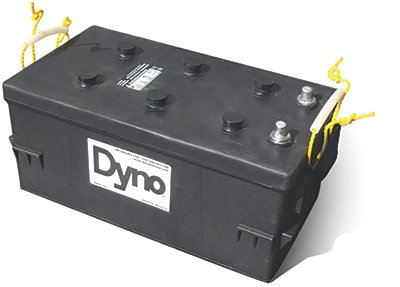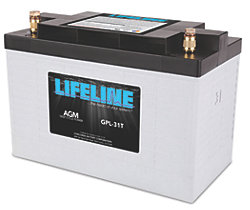Sizing Your Battery Bank
 When sizing a battery bank for your boat, the standard line has usually been to spend some time figuring out your daily energy needs, and then base the size of your batteries on that number. We believe that there is something else equally important to consider – namely, how much time do you want to spend listening to your engine running each day while you wait for the batteries to recharge?
When sizing a battery bank for your boat, the standard line has usually been to spend some time figuring out your daily energy needs, and then base the size of your batteries on that number. We believe that there is something else equally important to consider – namely, how much time do you want to spend listening to your engine running each day while you wait for the batteries to recharge?
With that in mind, this Navigator will take a deeper look at energy analysis, charge acceptance and battery bank size to help you arrive at a more realistic conclusion on what your needs are, before you make your purchase.
Conventional Energy Analysis
Analyzing your energy needs onboard is the most important step to determine how many amp-hours (a measure of electrical capacity) you will need in your battery bank. To do this, you need to first determine how many amps each electrical item on your boat consumes per hour. These items might include cabin lights, refrigeration, the stereo, VHF, instruments, running lights, etc.
To figure out how much they all draw – run each item individually while measuring how many amps are being drawn. Times this by how many hours you think the item will need to run during a 24-hour period. For instance – you plan to run several cabin lights for approximately 4 hours every day. All of the lights together use 5 amps per hour – so they will use a total of 20 amps over 24 hours.

To say this will vary from boat to boat is a complete understatement – but for this example let's say that your total came to 100 amp-hours. If we assume that we don't want to deplete our batteries more than 50% (since that can shorten their lifespan) then we need a battery bank with at least 200 amp-hours.
But if you only buy a 200 amp-hour battery bank, it means that you will be spending a lot of time every day charging your batteries – especially since recovering from a very deep discharge can take significantly longer than a lighter discharge. That's why there is still quite a bit more to consider...
Battery Ratings and Charge Acceptance
While it's great to know we use approximately 100 amp-hours a day, how do we figure out how long we will have to run the engine to get our batteries back to a 100% state of charge? For most of us, running our noisy, smelly and hot (!) engine to charge the batteries is not one of our favorite things to do – so it's pretty important to figure out how we can spend less time charging, and more time enjoying the silence. So let's take a look at how batteries are rated and what those ratings mean and then we'll see how charging and acceptance rates will help us answer the question of how long we'll need to charge.
| Side Note on Battery Voltage |
|
While a battery is considered completely “dead” (0% discharge left) at 10.5 volts, batteries are typically considered discharged if they reach a voltage of 11.9 volts. While voltage percentages vary by battery type, you normally want to keep your battery voltage between 12.45 to 12.75 volts for prolonged battery life. For more information on battery voltage and charging, read our How to Charge a Marine Battery article. |
Arguably one of the most important battery ratings to consider is reserve capacity (RC). This is the number of minutes a fully charged battery can maintain a “useful” voltage, while operating at a 25 ampere discharge rate at 80 ° F, until it is completely dead at 10.5 volts. The higher this number – the greater the battery's capacity for deep discharge before recharging is necessary – highly useful when looking at our house bank!
Also important is a battery's “cycle life” – which is the estimated total number of times a battery can go from a 100% charge, to a full discharge and back to a 100% charge again before failing – so obviously, the higher the cycle life, the longer your new battery is going to last.
Lastly, you want to look at the battery's amp-hour (Ah) rating – that is how many total amps the battery can reasonably deliver for 20 straight hours. This rating is what you're taking into consideration to make sure you have enough amp-hours to cover your daily energy needs.
So we're basically looking for a deep cycle battery that has a high reserve capacity, good cycle life and enough amp-hours to meet our daily needs. But what about how often we need to charge?
This brings us to another important factor of different battery types – the charge acceptance rate. The charge acceptance rate is the maximum rate at which your battery bank can be recharged – which will be determined by the type of batteries, their amp-hour rating and their current state of charge. Here are the general acceptance rates of the main battery types:
- Flooded (wet-cell) batteries have an acceptance rate equal to 25% of their amp-hour rating. So if you have two 8D size batteries with 220 amp-hours each wired in parallel, your 440 amp-hour bank has an acceptance rate of 110 amp-hours (440 x 25%).
- Gel batteries have a much higher acceptance rate of 40% of their amp-hour rating – so that same bank of batteries would have a charge acceptance rate of 176 amp-hours!
- AGM (Absorbed Glass Mat) batteries have the highest acceptance rate of all – an astounding 100% of their amp-hour rating. That means that our bank with AGMs would hypothetically have an acceptance rate of a whopping 440 amp-hours and could be recharged in one-fourth the time it would take to recharge a 440 Ah traditional wet-cell battery bank! That said, the chance of having an alternator that powerful is pretty slim, so while there are plenty of good reasons to buy AGMs, keep this in mind before you rush out to buy them for their charge acceptance capabilities alone.

So how does knowing the acceptance rate help us determine how big our battery bank should be or how long we will have to charge? By taking a look at how many amps our alternator can provide along with our acceptance rate, we can calculate exactly how long we will need to charge to recoup that 100 amp-hours we plan to use each day.
Continuing with the prior example – while all engines are different, let's say the alternator in this example has the ability to charge at 120 amps. Since my single flooded 8D battery (220 Ah) can only accept up to 55 amps of charge (even when the alternator can give more), I would need to run my motor for two hours to recoup the 100 amps I plan to use each day. Conversely, with a larger 660 Ah battery bank (capable of accepting 165 amps per hour) I can put in the full 120 amps my alternator can provide – which means I only have to charge for about 45 minutes to recoup that same 100 amps!
Back to the basics…
Now that we've overwhelmed you with all this technical information to consider, let's go back and review the basics. The most important factor in sizing your battery bank is figuring out your daily power needs. At a minimum, you should have enough amp-hours to at least double that number – with say a 20% margin for safety since you don't want to run your batteries down so much that you damage the battery plates or can't start your engine to recharge them.

It's imperative you do your homework and figure out what will work best on YOUR boat, keeping in mind your budget and how much space you have onboard, and how often (and how long) you want to run your engine. With a little bit of effort, your reward will be spending peaceful time at anchor without having to worry about running out of power.
We hope you've enjoyed this Navigator – but if you have additional questions, please read our related topics below – or feel free to contact our battery experts at (800) 426-6930.